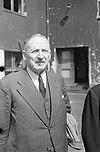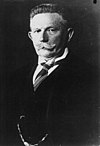Reich Ministry of Food and Agriculture
| Reichsministerium für Ernährung und Landwirtschaft | |
 | |
 The building of the Reich Ministry of Food and Agriculture on Wilhelmstrasse, during the Nazi era. After the interior was destroyed in World War II, the former palace, which had been earmarked for reconstruction in 1956, was demolished by the East Berlin municipal administration in 1960/62. | |
| Agency overview | |
|---|---|
| Formed | March 1919 |
| Dissolved | 8 May 1945 |
| Jurisdiction | Government of Weimar Republic Government of Nazi Germany |
| Minister responsible |
|
The Reich Ministry of Food and Agriculture (German: Reichsministerium für Ernährung und Landwirtschaft, abbreviated RMEL) was responsible for the agricultural policy of Germany during the Weimar Republic from 1919 to 1933 and during the Nazi dictatorship of the Third Reich from 1933 to 1945. It was headed by a Reichsminister under whom a state secretary served. On 1 January 1935,[1] the ministry merged with the Prussian Ministry of Agriculture, Domains and Forests, founded in 1879. Until 1938 and the Anschluss with Austria, it was called the "Reich and Prussian Ministry of Food and Agriculture".[2] After the end of National Socialism in 1945 and of the Allied occupation of Germany, the Federal Ministry of Food and Agriculture was established in 1949 as a successor in the Federal Republic of Germany (West Germany).
History[edit]
In March 1919, the Reich Office of Food (Reichsernährungsamt) established the Reich Ministry of Food. It was combined with the Reich Ministry of Economics in September 1919 and re-founded during the Kapp Putsch in March 1920 under the name Reich Ministry of Food and Agriculture. In the same year, the ministry moved into the Palace of Prince Alexander and Prince George at 72 Wilhelmstrasse in Berlin.[3] From 1924, four large-format paintings by August Weber were on loan in the building. Since 1945 they have been considered lost.
After the Nazis seized power on 30 January 1933, the ministry was initially led by Alfred Hugenberg. Coerced into resignation in June 1933, Hugenburg was succeeded by Kurt Schmitt (minister of economics) and Walther Darré (minister of food and agriculture).[4][page needed] The latter took over the management of the Reich Ministry of Food and Agriculture as Reich Farmers' Leader (Reichsbauernführer) on 30 June 1933.[5] In this function he was also responsible for the Reichsnährstand (loosely, Reich Bureau of Food and Nutrition), which had been created for the "co-ordination" (Gleichschaltung) of German agriculture. Darré simultaneously headed the Office for Agricultural Policy (from 1936, Reich Office for Agricultural Policy; from 1942, Reich Office for Rural Inhabitants), which belonged to the party's official apparatus and was responsible for the management and supervision of the Reich Bureau of Food and Nutrition.[6]
The RMEL essentially took over the state's oversight of the Reichsnährstand organization.[7] As a result, individual areas of responsibility were gradually transferred to other National Socialist authorities. In 1934, for example, the Reich Forestry Office (Reichsforstamt), under the leadership of Hermann Göring, was created as the supreme Reich authority for forestry and hunting, the timber industry, nature conservation and the preservation of natural monuments.[8] The Reich Forestry Office was in turn united on 1 January 1935 with the Prussian State Forestry Office.[9] Goring's deputy and the de facto head of German Forestry was Walter von Keudell, and then from 1937 Friedrich Alpers. Furthermore, in 1934 and 1935, the agricultural vocational and technical school system was transferred to the Reich Ministry of Science, Education and Culture, and veterinary medicine was transferred to the Reich Ministry of the Interior.[10] On 22 September 1938, by decree of the Reich minister, all research institutes in the fisheries sector were consolidated in the Reich Institute for Fisheries.[8]
Reich ministers[edit]
| No. | Portrait | Reichsminister | Took office | Left office | Time in office | Party | Cabinet |
|---|---|---|---|---|---|---|---|
| 1 | Robert Schmidt (1864–1943) | 13 February 1919 | 26 March 1920 | 1 year, 42 days | SPD | Scheidemann Bauer | |
| 2 | Andreas Hermes (1878–1964) | 27 March 1920 | 10 March 1922 | 1 year, 348 days | Centre | Müller I Fehrenbach Wirth I Wirth II | |
| 3 | Anton Fehr (1881–1954) | 31 March 1922 | 21 November 1922 | 256 days | BB | Wirth II | |
| 4 | Karl Müller (1884–1964) | 22 November 1922 | 25 November 1922 | 4 days | Centre | Cuno | |
| 5 | Hans Luther (1879–1962) | 1 December 1922 | 4 October 1923 | 317 days | Independent | Cuno Stresemann I | |
| 6 | Gerhard Graf von Kanitz (1885–1949) | 6 October 1923 | 5 December 1925 | 2 years, 62 days | Independent | Stresemann I Marx I Stresemann II Marx II Luther I | |
| 7 | Heinrich Haslinde (1881–1958) | 20 January 1926 | 17 December 1926 | 331 days | Centre | Luther II Marx III | |
| 8 | Martin Schiele (1870–1939) | 28 January 1927 | 12 June 1928 | 1 year, 136 days | DnVp | Luther II Marx IV | |
| 9 | Hermann Dietrich (1879–1954) | 28 June 1928 | 27 March 1930 | 1 year, 272 days | DDP | Luther II Müller II | |
| (8) | Martin Schiele (1870–1939) | 30 March 1930 | 30 May 1932 | 2 years, 61 days | DnVp CNBL | Brüning I Brüning II | |
| 10 | Magnus Freiherr von Braun (1878–1972) | 1 June 1932 | 28 January 1933 | 241 days | DnVp | Papen Schleicher | |
| 11 | Alfred Hugenberg (1865–1951) | 30 January 1933 | 29 June 1933 | 150 days | DnVp | Hitler | |
| 12 | Richard Walther Darré (1895–1953) | 30 June 1933 | 23 May 1942 (On leave until 6 April 1944) | 8 years, 327 days | NSDAP | Hitler | |
| 13 | Herbert Backe (1896–1947) | 23 May 1942 (Acting until 6 April 1944) | 23 May 1945 | 3 years, 0 days | NSDAP | Hitler Goebbels Schwerin von Krosigk |
State secretaries[edit]
| Name | Appointed | End of Term | Political Party |
|---|---|---|---|
| Ludwig Huber | 1920 | 1922 | Independent |
| Carl Heinrici | 1922 | 1923 | Independent |
| Fred Hagedorn | 1923 | 1926 | Independent |
| Erich Hoffmann | 1926 | 1929 | Independent |
| Hermann Heukamp | 1929 | 1932 | Independent |
| Fritz Mussehl | 1932 | 1933 | Independent |
| Hans Joachim von Rohr | 1933 | 1933 | DNVP |
| Herbert Backe | 1933 | 1944 | NSDAP |
| Werner Willikens | 1934 | 1945 | NSDAP |
| Hans-Joachim Riecke | 1944 | 1945 | NSDAP |
References[edit]
- ^ Neugebauer, Wolfgang, ed. (1992). Handbuch der preussischen Geschichte [Handbook of Prussian History] (in German). Vol. 2. Berlin / New York: W. de Gruyter. p. 603. ISBN 3-11-008322-1.
- ^ Tauber, Joachim, ed. (2006). Archivführer zur Geschichte des Memelgebiets und der deutsch-litauischen Beziehungen [Archive Guide to the History of the Memel Region and German-Lithuanian Relations] (in German). München: Oldenbourg. p. 284.
- ^ Kalbe, Riki; Zuckermann, Moshe (2000). Ein Grundstück in Mitte. Das Gelände des künftigen Holocaust-Mahnmals in Wort und Bild [A Plot of Land in Mitte. The Site of the Future Holocaust Memorial in Words and Pictures] (in German). Göttingen: Wallstein. p. 22. ISBN 3-89244-400-5.
- ^ Kehrl, Hans (1973). Krisenmanager im Dritten Reich [Crisis Manager in the Third Reich] (in German). Düsseldorf: Droste. ISBN 978-3770003556.
- ^ Gies, Horst (1967). "NSDAP und landwirtschaftliche Organisationen in der Endphase der Weimarer Republik" [NSDAP and Agricultural Organisations in the Final Phase of the Weimar Republic] (PDF). Vierteljahrshefte für Zeitgeschichte (in German). 15 (4): 375.
- ^ Kluge, Rudolf; Krüger, Heinrich (1939). Verfassung und Verwaltung im Großdeutschen Reich [Constitution and Administration in the Greater German Reich] (in German) (2nd ed.). Berlin: P. Schmidt. p. 196.
- ^ Gies, Horst (1981). "Die Rolle des Reichsnährstandes im nationalsozialistischen Herrschaftssystem" [The Role of the Reichsnährstand in the National Socialist Ruling System]. In Hirschfeld, Gerhard; Kettenacker, Lothar (eds.). Der "Führerstaat". Studien zur Struktur und Politik des Dritten Reiches (= Veröffentlichung des Deutschen Historischen Instituts London. Band 8) [The "Führer State". Studies on the Structure and Politics of the Third Reich (= Publication of the German Historical Institute London. Volume 8)] (in German). Stuttgart: Klett-Cotta. p. 274. ISBN 3-12-915350-0.
- ^ a b Tauber 2006, p. 286 f.
- ^ Radkau, Joachim, ed. (2003). Naturschutz und Nationalsozialismus [Nature Conservation and National Socialism] (in German). Frankfurt a. M. / New York. pp. 88, note 52. ISBN 3-593-37354-8.
{{cite book}}: CS1 maint: location missing publisher (link) - ^ Tauber 2006, p. 284.
External links[edit]
"Reichsministerium für Ernährung und Landwirtschaft". Deutsche Digitale Bibliothek (in German). 2008. Retrieved 27 June 2023.



![Anton Fehr [de]](http://upload.wikimedia.org/wikipedia/commons/6/6d/No_image.png)







